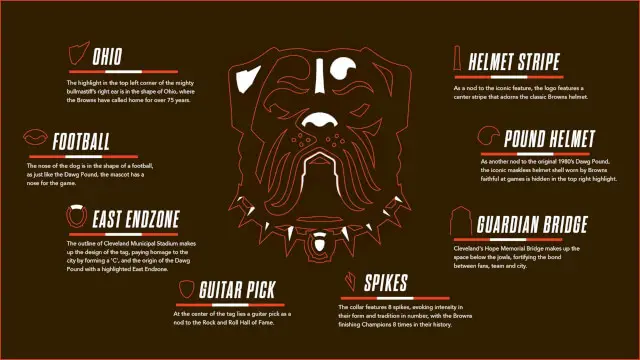It is no secret that the Cleveland Browns have a long and storied history as a franchise. The Cleveland Browns were founded in 1944. The franchise was named after a man by the name of Paul Brown. Paul Brown was the franchise's co-founder and original head coach. Initially, the franchise competed in a league known as the All-America Football Conference from 1946-1949. The league folded after the 1949 season.
During the 1950 season, the Cleveland Browns became affiliated with the NFL and are still a part of the league today. Legendary players like Jim Brown, Otto Graham, and Ozzie Newsome have played for this franchise.
Although the Cleveland Browns have never won a Super Bowl, the franchise has enjoyed championship success. They won a championship every season of the All-America Football League's existence. The franchise also won 4 NFL Championships before the NFL merged with the AFL in 1964.
Recently, the Cleveland Browns announced the adoption of a new dawg-themed alternative logo. In this piece, we will go over the design of its logo and its connections with other brand identifiers that the franchise has had in the past.
In terms of the Browns' logo history, there is quite a difference between its primary and alternative logo history. The first two logos that the Cleveland Browns centered around an elf known as "Brownie Elf." These logos lasted a combined 21 years. After that, the primary logo history of the Cleveland Browns is pretty uniform and straightforward.
It's uniform because Cleveland Brown's logo consists of orange helmet logos. The franchise has stuck with this format for the last 50 years. There were various versions of the helmet logos with differences in the helmet stripes as well as the colors of the facemasks. However, their primary logo offerings had no history of dawg logos.
However, dawg logos are in quite a few of the alternative logos. The first alternative dawg logo was introduced in 1999 and lasted until 2002. This logo consisted of a brown and white dawg wearing an orange helmet. An orange football can be seen in his teeth.
From 2003-2014, the Browns adopted another dawg logo. The logo was a brown, black, and orange dawg. He has an intimidating scowl.
From 2015-2023 the Browns would adopt another dawg logo. The dawg was colored black with a white outline. He is snarling viciously.
The Browns recently revealed an updated new logo chosen by the Browns fanbase. The franchise held a contest in which fans were asked to design the new logo. The process of choosing the winner took two months. However, the winning logo has been revealed.
 Sports Logo History
Sports Logo History
The bottom of the logo contains a spiked dawg collar. The spikes were colored black with comprehensive outlines.
The hidden symbols in this logo make this design a great logo.
The dawg's right ear has a depiction of the State of Ohio. It can be seen in the fact that the dawg's nose is shaped like a football.
Additionally, the dawg has a white stripe in the middle of his forehead. This was a shoutout to the previous helmet logos containing a white stripe.
Symbols can also be seen on the spiked dawg collar at the bottom of the logo. The middle of the spikes contains a depiction of a guitar pick. The guitar pick was a nod to the Rock and Roll Hall of Fame venue based in Cleveland.
There are eight spikes in the dawg collar. The eight spikes represent the eight championships won by the Cleveland Browns throughout their history.
Sports Logo History is a community of sports logo enthusiast who enjoys the history of each team’s logo history. Sports Logo History has primary logos, alternate logos, or wordmark logos from the NFL, NBA, MLB, MLS, NHL, Premier League, WNBA, CFL, NCAA, ABA, USFL, AAF, and XFL.
One of our partner sites Sports Team History takes a look at the history of each and every professional sports team. In addition, we have added Sports News History to our sports history websites. 24/7 non-stop sports news that's worth knowing. Finally, the premier sports team marketplace for your favorite team or college with thousands of items for you to peruse at Sports Market History.

